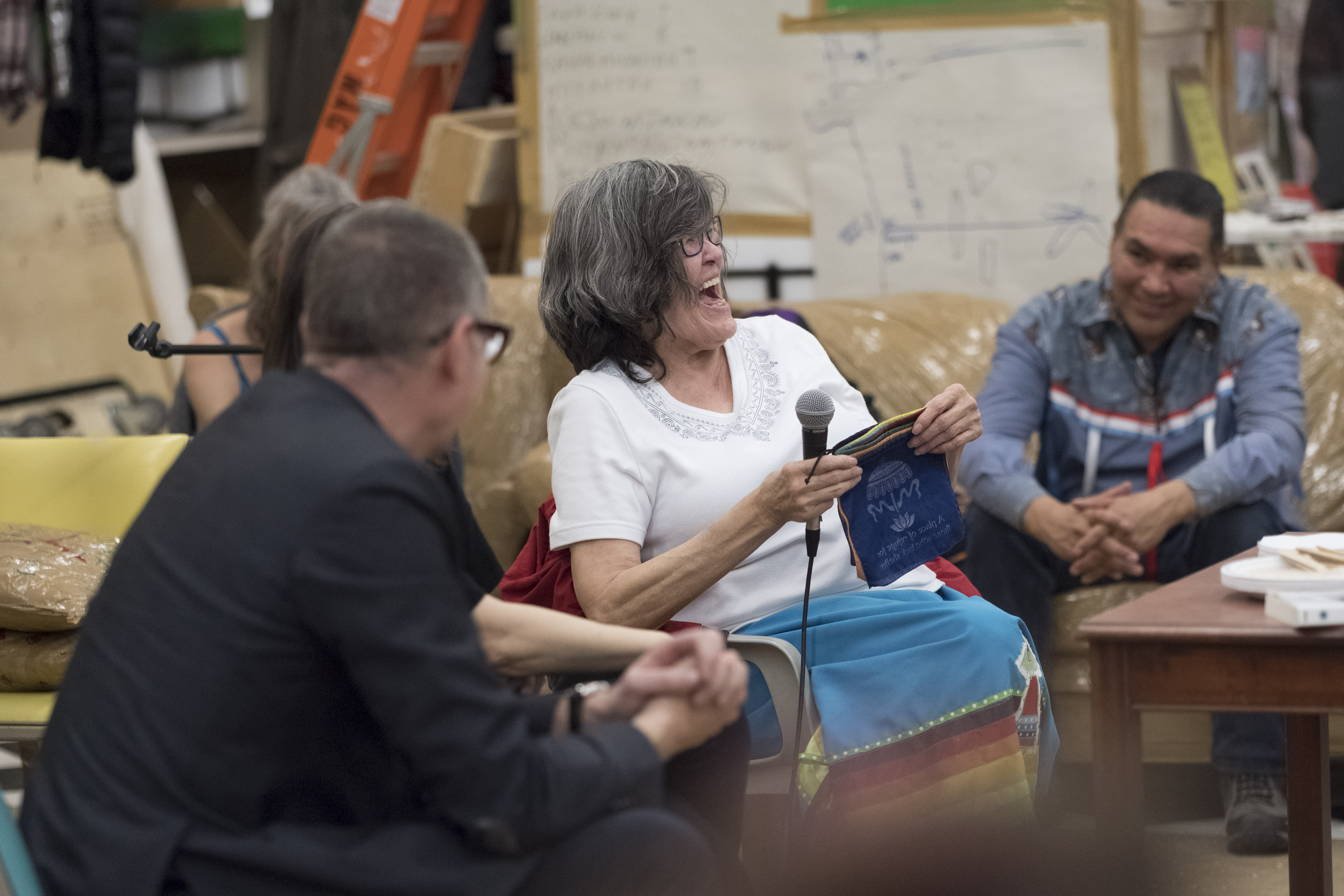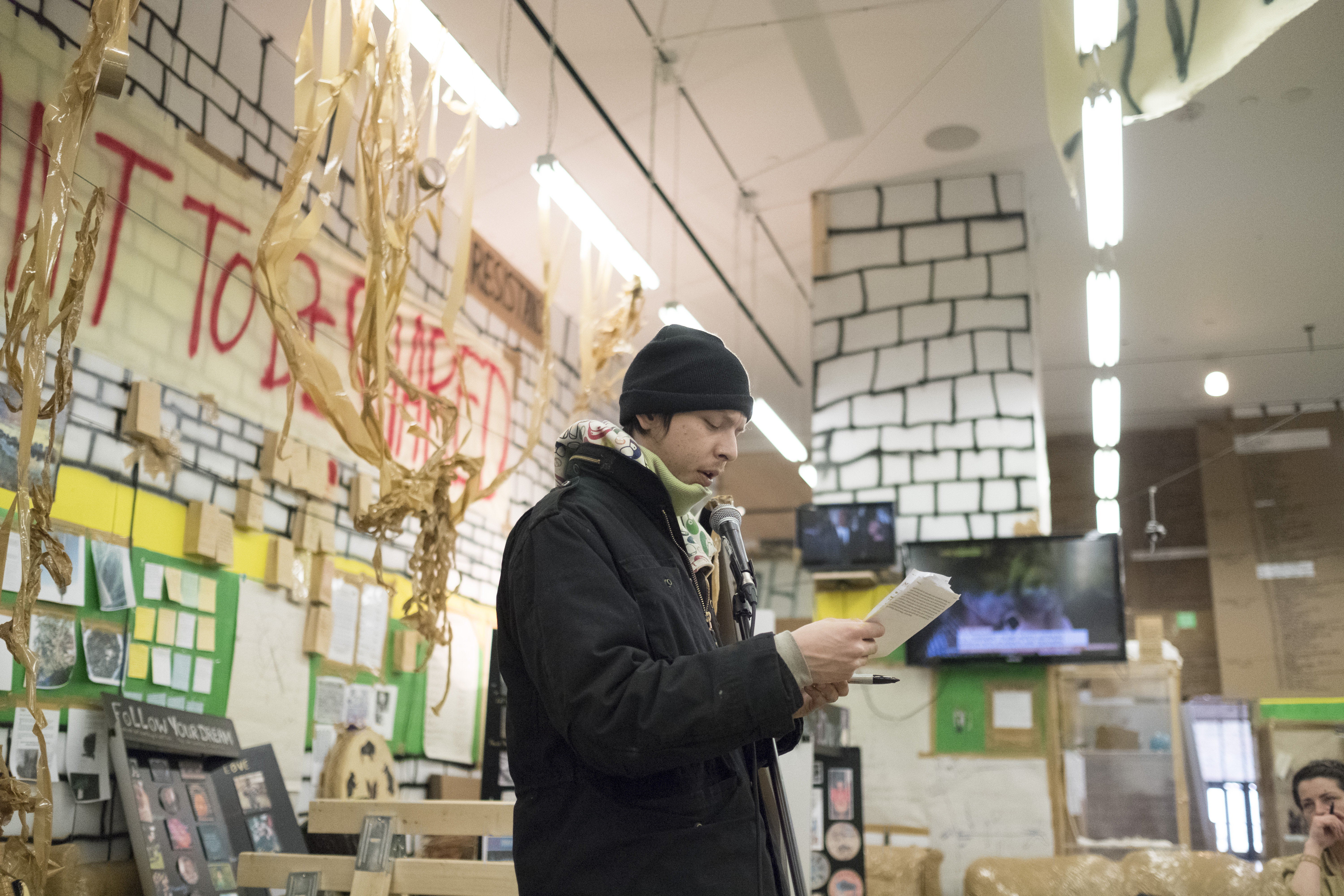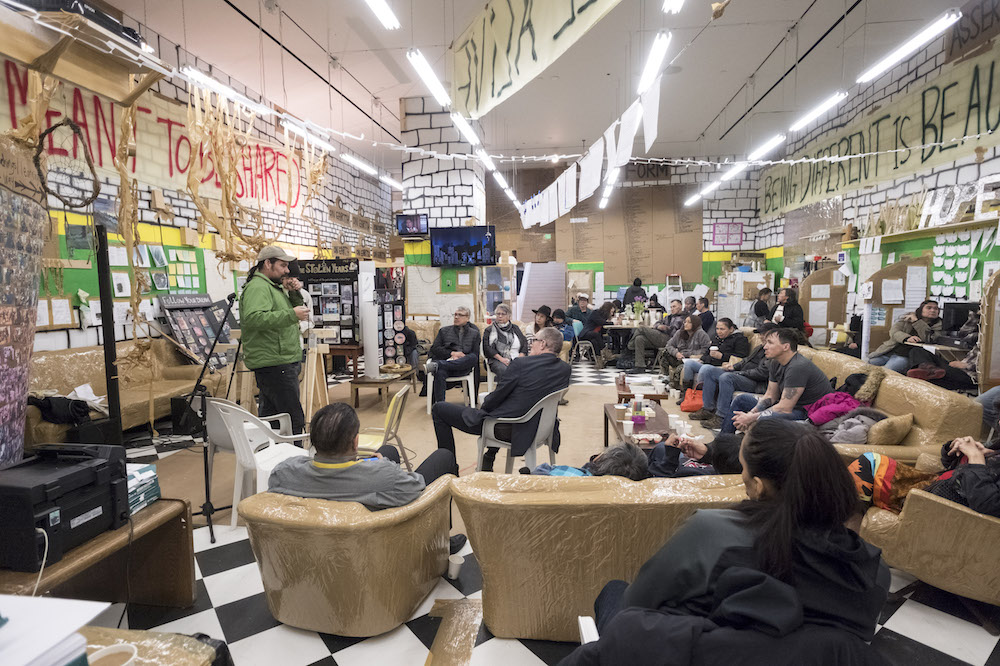Three months ago, I bought a CD of poetry from Johnny Marceland, a sixty-year-old Dene man who lives in my hometown of Saskatoon. Throughout February, Marceland performed at Saskatoon’s brand new, eighty-five million dollar Remai Modern, as part of Thomas Hirschhorn’s artwork What I can learn from you. What you can learn from me (Critical Workshop). Sometimes set to music, his poems are affirmative, upholding the possibility that Indigenous people can outstrip the colonial abuses that often cruelly sabotage their lives. But back in my Berlin apartment, the CD-R crackles with the inter-racial dynamics that structure Canadian life, even in gestures of seemingly good faith. It’s now taken on a signification beyond the writer’s words: the dubiously warm feeling of having gone back home, participated, and supported. Put another way, the album has become a fitting metonym for Hirschhorn’s project.
For years, the Swiss artist made “monuments” to his favorite philosophers: ersatz community centers of cardboard, wood, utility tape, spray-painted banners, and printed matter. What I can learn was a new variation, with the citations of vaunted European thinkers – along with the Eurocentric viewpoint they imply – thankfully dialed down. Within a ramshackle environment constructed in the Remai’s free-admission Connect gallery, an open invitation was issued. Visitors could give half-hour lessons on a subject of their choice, in exchange for a $100 honorarium. Gallery access became free for anyone who picked up one of several packing tape wrist-bands, hung on the wall.
After Gramsci Monument (2014) in the South Bronx Forest Houses, Hirschhorn’s work became a locus of serious ethical questions. Reflecting on the response to a white European artist setting up his pedagogical shop in an African American and Latino neighbourhood, Whitney Kimball wrote that the artworld had “mostly cried colonialism.” For many, Hirschhorn was at best naive and at worse an egomaniacal white savior. In Artforum, Glenn Ligon – who lived in Forest Houses as a child and whose work has regularly dealt in African American motifs – expressed similar reservations before conceding to the community’s own, largely appreciative reception.

Thomas Hirschhorn, What I can learn from you. What you can learn from me (Critical Workshop), 2018. Installation view with Elizabeth Ahenakew. Courtesy of Remai Modern. Photo: Dave Stobbe.
In contrast to Ligon’s response, there was something strange and spasmodic about the most direct critiques: an eagerness to dismiss the work that seemed more self-exculpatory than considered. The New York Times’s Ken Johnson – who is white – was “sad” that his own “vision of the great man descending upon the benighted residents … to spread his manna and impregnate the community with an embryo of hope,” had not manifested. It’s evident that Johnson is being ironic. But his barb reads more an embittered caricature than a good-faith reflection of the project’s intention or effect. Then there was photographer Chris Arnade – also white – who complained about a sparsely-attended philosophy lecture, before disappointingly describing local kids just hanging out in the Gramsci Monument‘s computer room. He seemed to miss the crucial point that such a scene was perversely novel in the un-wired housing project.
Fair enough. So did I, in Saskatoon. But in a society defined by aspirational narcissism and political cynicism, actual political engagement – especially across lines of race and class – necessarily risks naiveté. In this world, the decks are stacked wickedly against social progress; an obsession with for-profit work has become a structural obstacle to committed empathetic encounters outside the close boundaries of friends and family (and sometimes even within them). To be sure, difficult problems arise anytime a white artist goes to work in a marginalized community. But these criticisms need to be coupled with scrupulous attention to context and actual effect; confronting the complications of Hirschhorn’s project at least improves upon the straightforward barbarity of a society that has learned to regard racist and classist predations as an inalienable fact of life. It’s unsurprising that the loudest potshots against Hirschhorn were not taken by community members, but by writers who benefit from their closeness to a socio-economically dominant white culture.
Johnson and Arnade saw what they saw in the Bronx, but here’s what happened in Saskatoon. Despite Hirschhorn’s invitation being circulated openly, Indigenous speakers largely defined the curriculum. For the unjustly brief period of one month, disempowered people took part in creating a platform not governed by institution or authority. The release-valve of social culpability for the crimes of poverty and racial segregation that such temporary projects offer isn’t without problems. But it’s necessary to join this critique with the fact of these participants having access to a regular and responsive audience in a colonial environment destructive of such positive opportunities. Consistently, these listeners were comprised not only of Hirschhorn and white gallery visitors, but many Indigenous people – both leaders in the community, and those oppressed by the racist distribution of poverty. Unflaggingly, the artist sat and prepared questions for the speakers. In many cases he knew their names and details of their lives outside the gallery. In addition to an opportunity to be heard, the more imperiled participants also had a safe, warm, energized place stocked with snacks and coffee. The barren difficulty of inner-city life in winter Saskatchewan shouldn’t be forgotten here. And the fact that this paltry offering seemed substantial precisely highlights the absence of care that Hirschhorn’s project filled.
For those accustomed to having people listen to them, this project may seem insignificant. But in this environment – where the province recently slashed funding for inner-city arts, and where Saskatoon’s already depressive homeless shelter is threatened by cuts – it had substantive and complex consequences. After each talk, Hirschhorn recorded the lecturers’ names and topics on sheets of cardboard, which eventually spilled across the wall. The list’s growth mirrored that of Hirschhorn’s mutinous interior design, with the cacophony of art projects and writings accumulating day by day. The aesthetic suggested the democratic possibilities latent in art, as in: “anything is possible no matter what you have,” but also, from a more critical perspective, “make do, because this is all you’re getting.”
Like many places in Canada, Saskatoon is a city grounded in unceasing colonial aggression: reservations, residential schools, a racist police force, a judiciary complicit in the conversion of prisons into silos for prejudicially-criminalized First Nations people. What I can learn attained deceptive complexity by interspersing arduous personal accounts of this world with other material: expositions on fly-fishing and manga comics sat alongside Indigenous teachings. Because of the project’s emphasis on dialogue, even the most brutal presentations replaced simplistic stigmatization with complex reflection. The psychological effects of being homeless in a place where winter drops to -36 C were memorably laid out by one presenter. Lectures on hip-hop by local teenagers were no less meaningful; likewise the bannock, freshly-baked by a lecturer named Shannon Redwood.
After visiting Saskatoon, Hirschhorn described the “visual shock” of racist segregation and poverty. Such revelations are the result of privilege suddenly encountering its opposite. At the Remai’s autumn opening, a friend was conversing with two Indigenous men, who were briskly moved along by police officers under the impression that “they were bothering” the white guests. This is how marginalized people are surreptitiously barred from spaces like the Remai, in Saskatoon and elsewhere. Projects like this don’t come close to remedying the exclusivity of art, or curing a society of a thorough and utterly normalized segregation. But they may provide a model for how reconciliation can look.

Thomas Hirschhorn, “What I can learn from you. What you can learn from me., critical workshop,” 2018. Installation view with Brady Doucette. Courtesy of Remai Modern. Photo: Dave Stobbe.
Lyndon J. Linklater, a Plains Cree/Ojibway man from Thunderchild First Nation who also works as the museum’s Indigenous Relations Advisor, told me that prior to his project, Hirschhorn came to Saskatoon four times, visiting local shelters in order to understand the city’s dynamics, and inquiring “about protocol and Indigenous perspective.” As a result, the project’s content was shaped by the people it featured, even as its form retained Hirschhorn’s distinctive stamp. Which brings us to the work’s most crucial takeaway: the point is not only to grant disenfranchised people – “the non-exclusive audience,” as per Hirschhorn’s rhetoric – access to extant spaces and languages of contemporary art. It’s to allow for a changing understanding of how that language should look in order for power positions within contemporary art to begin opening themselves to those long left outside.
The closing of What I can learn comprised a series of participant reflections capped by a smudging ceremony. Hirschhorn contributed a typically-impassioned mission statement, capped by his opinion that “there is no reason to be sad that this project is ending.” On this point he is unambiguously wrong (it’s in statements like these that the artist’s rhetoric turns on him). The artist consistently maintains that his works are not social-service initiatives, but art: a strategy that risks aestheticizing human beings in need. At its best – and in the most sympathetic reading – Hirschhorn’s approach can displace the social labeling of people, turning the gallery into a tabula rasa where people aren’t cold, starving, or physically threatened. But he doesn’t do himself any favors when defending the limited duration of his project on abstruse philosophical grounds. A plane ticket back to Europe may quell his sadness, but the people who partook daily in the piece, staying for hours each time, face a starkly contrasting emotional challenge.
At that closing ceremony a woman named Chickadee, who spends her days and nights advocating for the homeless from her wheelchair, expressed remorse that yet another promising initiative was ending. After the Gramsci Monument finished in the Bronx, artist and writer Lex Brown, who was employed on the project, wrote that “it is beyond sad … I cried a lot, at the end, and months after, and still today. I feel sad. But I feel more sorrow for other things, that are forcefully taken from people of color, things like civil rights, and education, and accurate retellings of history.”
As Glenn Ligon concluded in 2013, Hirschhorn’s “project inevitably suggests” that, in order for its ethic of non-exclusion to be fully realized, it should be extended indefinitely. It’s clear that the correct course of action would be to incorporate What I can learn into the Remai – structurally, concretely, permanently. Back in the Bronx, Erik Farmer, the Tenants Association president at Forest Houses, responded to the suggestion:
… I would like that … They can have the kids doing art and crafts, running a newspaper, stuff like that. [It gives them] another outlook on things. They like art now … I’m trying to keep their minds off of all this. Let them know that there’s more to the world than this. Just keep their minds open a little bit.
The job of an empowered art audience is to push the matter forward. If the language of civic responsibility seems too weighty, consider Hirschhorn’s project in light of the central premises of contemporary art. In 1957, Marcel Duchamp wrote that “The creative act is not performed by the artist alone; the spectator brings the work in contact with the external world …” In other words, the viewer completes art’s meaning. If this project’s meaning is non-exclusivity, it’s regrettably unfinished.























